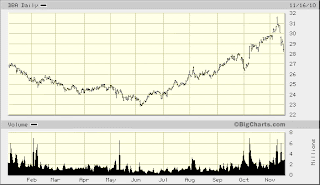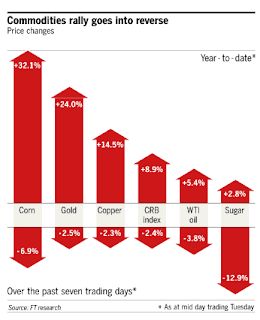The large selloff in commodities today gives back the gains since around September. In my view much of this reflects those way late to the party who bought in amid the front page articles of late (see my blog of Nov 11). Technical analysis as I look at it expresses the behavioral economics observations about investors in real time and these charts reflect much of those recent flows into commodities taking losses or getting out at break even. Technical analysis would see the next wave of recent buyers selling off at their entry point of buyers around september (hence support in technical analysis jargon) or for those holding on they would be sellers at the recent highs (resistance)
agricultural etf
 |
| Agriculture Etf (DBA) |
 | ||
| copper |
 | |||||||||
| silver etf (SLV) |
 |
| Emerging Market Etf (WWO) The FT today had an excellent piece on the commodity selloff. .My bolds: A steep slide in commodity prices that sent sugar tumbling 23 per cent in just two days has brought an abrupt halt to the apparently unstoppable bull run that has brought many markets to multi-year highs. Is this the start of a “great correction” or just a blip? ….. The scale of the sell-off in sugar has been impressive. Prices suffered their biggest one-day decline in 30 years on Friday. The benchmark Reuters-Jefferies CRB index, a basket of raw materials, dropped more than 3.5 per cent on the same day, the biggest fall since April 2009. Commodity prices continued to fall on Tuesday. Analysts, though caught out by the suddenness of the slide, were not wholly surprised that it happened. Before the sell-off, they say, prices had looked stretched following a powerful rally. A correction was on the cards. As Jonathan Kingsman, a Swiss-based soft commodities consultant, says: “The higher they climb, the harder they fall.”... As prices started to drop, some hedge funds and other big investors moved aggressively into profit-taking mood, accelerating the sell-off as they tried to lock in their strong annual gains to protect their performance and bonuses. In some cases, that selling pressure quickly turned into a rout as falling prices triggered a string of automatic sell orders on the way down. But a closer look reveals that many commodities prices are well anchored and still trading near multi-year highs. Analysts and traders say markets are well supported by robust supply and demand fundamentals. “The fundamentals have not changed overnight,” says Michael Lewis, head of commodities research at Deutsche Bank in London, referring to strong demand from China, the world’s biggest importer of raw materials from copper to soyabeans, and other emerging countries, and weak supply growth. Instead, brokers and traders say the sell-off has simply removed much of the speculative froth from the market. Richard Feltes, vice-president at futures brokerage RJ O’Brien in Chicago, says that “overloaded commodity longs” have retreated to the sidelines. Away from the volatility of futures trading, many physical commodities markets remain tight. High volatility markets are the best candidates for benefitting from the rebalancing premium. |

2 comments:
Hey Lawrence,
Didn't see anywhere to contact you so I'll just post my message here.
I just read your last article on "dumb money" and I couldn't agree more. I was wondering if you were interested in doing a guest post on our blog (http://optionalpha.com/blog) sometime? Of course if would have to be options, technical analysis, or stock trading related but you would get a back-link to your site.
Please let me know if your interested and we both can work out a schedule for this coming week.
Hopefully you are! Take care and happy trading!
Kirk Du Plessis
lweinman@lweinmanadvisor.com
Post a Comment